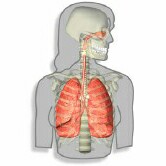Ventilator Relieves Lung Cancer Pain in Final Hours
At end of life, it may be better than standard oxygen therapy, study suggests.
By Randy Dotinga
HealthDay Reporter
|
E-mail this article
Subscribe to news
Printer friendly version
|

(SOURCES: Stefano Nava, M.D., chief, respiratory critical care unit, Istituto Scientifico di Pavia, Pavia, Italy; Neil Schachter, M.D., professor, pulmonary medicine, Mount Sinai Medical Center, New York City; news release, American Thoracic Society; May 20, 2008, American Thoracic Society 2008 International Conference, Toronto)
TUESDAY, May 20 (HealthDay News) -- New research suggests that a mechanical ventilator can ease suffering and help lung cancer patients avoid sedation at the end of life.
A large percentage of these patients didn't want to have anything to do with a ventilator, which requires them to wear an oxygen mask. But those who were willing to try the treatment needed less morphine and had fewer symptoms in their final hours.
The findings could change the way doctors treat lung cancer patients in the end stages of their disease, said study author Dr. Stefano Nava, chief of the respiratory critical care unit at Istituto Scientifico di Pavia in Italy.
According to Nava, the ventilator approach could "provide some relief to patients and a better quality of dying."
At issue are lung cancer patients who typically only have a matter of hours or days to live. They often suffer from pain and difficulty breathing.
One approach is to help the patients breathe with the use of oxygen that reaches their lungs through nasal tubes. This approach, known as standard oxygen therapy, is used by many patients with lung conditions.
Another approach relies on mechanical ventilators, which use pressure to push oxygen into the lungs. The ventilators require the use of a face mask.
According to Nava, no studies have compared the two approaches in end-stage lung cancer patients.
Nava and his colleagues in Italy and Spain randomly assigned 92 patients to either of the two treatments. Eighteen other patients declined to accept the ventilator treatment after trying out the masks; another five declined after trying the standard oxygen treatment.
The findings were scheduled to be released Tuesday at the American Thoracic Society's International Conference, in Toronto.
The researchers found the ventilator treatment reduced discomfort and difficulty breathing at one, three and 24 hours. It took three hours for those on the standard oxygen therapy to experience improvement.
The patients on ventilators also needed much less morphine.
Dr. Neil Schachter, a professor of pulmonary medicine, said the findings could help doctors make better decisions. "There now appears to be an alternative way of making what is really a very horrible situation more comfortable for the person who is dying," said Schachter, medical director of the respiratory care department at Mount Sinai Medical Center in New York City.
The ventilator treatment appears to reduce the sensation of breathlessness in the patients. That, he said, could mean less need for sedation.
"By doing it in this way, you're not sedating them, making them go to sleep," he said. "They can presumably have a better interaction with their family in these last moments."
In another study to be released at the conference Tuesday, Veterans Administration-funded researchers report that so-called "pulmonary rehabilitation" -- which includes counseling and instruction in lung exercises -- provides less relief for patients with chronic obstructive pulmonary disease if given late in the course of their disease.
The finding, "suggests that treatments for end-stage patients with COPD may still be effective and introducing exercise training sooner in the course of their disease results in more improvement," lead researcher Bonnie Steele, a respiratory clinical nurse specialist at the VA Puget Sound Health Care System in Seattle, said in a statement.
More information
Learn more about lung cancer from the U.S. National Cancer Institute.
Copyright © 2008 ScoutNews, LLC. All rights reserved. 
HealthDayNews articles are derived from various sources and do not reflect federal policy. healthfinder.gov does not endorse opinions, products, or services that may appear in news stories. For more information on health topics in the news, visit the healthfinder.gov health library.